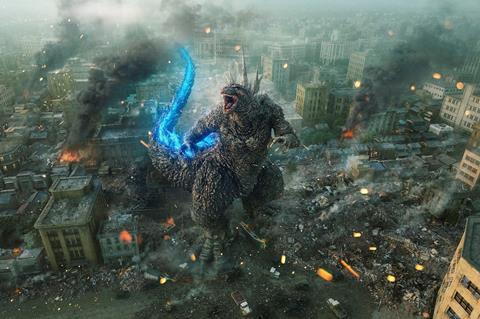Japanese-produced Godzilla film is a confident crowd-pleaser which throttles recent Hollywood remakes

Dir/scr: Takashi Yamazaki. Japan. 2023. 125mins
Primal terror and psychic wound, Godzilla is brought to ferocious life in writer-director Takashi Yamazaki’s gripping monster movie. Nearly 70 years after the release of the original film, Godzilla Minus One returns the titular beast to its roots as a metaphor for Japan’s postwar anxiety and grief, in the process delivering a stirring spectacle that also contains a palpable emotional undercurrent. Buoyed by impressive effects work supervised by Yamazaki, this confident crowd-pleaser throttles the recent Hollywood remakes, much like Godzilla pulverising another metropolis.
This confident crowd-pleaser throttles the recent Hollywood remakes
Already released in Japan, where it achieved nearly $7m in its opening weekend and broke IMAX records for a live-action film, Godzilla Minus One opens in the US on December 1 and the UK on December 15, hoping to attract genre fans uninterested in the season’s more mainstream fare. (The presence of stars Ryunosuke Kamiki and Minami Hamabe may also provide a commercial boost.) The first Japanese-produced Godzilla picture since 2016’s Shin Godzilla ($78 million worldwide), the film will be competing with the recent Warner Bros. releases Godzilla: King Of The Monsters ($387 million) and Godzilla vs. Kong ($470 million). Expect strong reviews and glowing word-of-mouth.
Set in the 1940s in the wake of the Second World War, the picture introduces us to Koichi (Kamiki), a cowardly kamikaze pilot who escaped his destiny by faking a mechanical error in his plane. But with the war over, he faces a new danger when Godzilla attacks, threatening the Asian nation still reeling from death and devastation. Befriending a young woman named Noriko (Hamabe) who, like him, has lost her parents, they jointly raise an abandoned baby, Akiko, while he teams up with scientists and others to defeat this seemingly invincible foe.
Veteran blockbuster filmmaker Yamazaki crafts his Godzilla picture with an eye towards ensuring that the action set pieces capture the right amount of awe-inspiring scope. Towering over mere mortals, Godzilla is a remorseless killing machine, its jagged dorsal plates cutting through the water like a shark’s fin – except infinitely more terrifying. With a deafening cry and an ability to blast powerful radiation rays from its mouth, the monster shows no mercy. But Naoki Sato’s booming, mournful orchestral score suggests that Godzilla is a symbol of something greater — the horror and inexplicable agony of the brutal war the Japanese have just endured.
This idea, of course, was central to the 1954 Godzilla, released less than a decade after the end of the Second World War, and Yamazaki populates the film with characters who have already suffered so much, barely able to comprehend tackling this frightening monster. Godzilla Minus One exudes an underdog spirit as Koichi and his comrades find inner strength in order to save the day, although this life-or-death battle is about more than defeating Godzilla — indeed, it is a rallying cry for a grieving nation to put the past behind it and fight its way to a brighter future.
As is often the case with monster movies, the proceedings lose a little momentum when Yamazaki focuses on the humans. Kamiki and Hamabe, who star together on the Japanese series Ranman, have a likeable rapport, even if their characters are one-dimensional. Koichi is especially cliched as the cowardly pilot who, predictably, will eventually find himself in another dramatic situation in order to prove his bravery. The supporting players are also very much types, although Hidetaka Yoshioka acquits himself well as Noda, the resident genius who will come up with a fairly brilliant plan for toppling Godzilla.
Serving as the effects supervisor, Yamazaki produces a suitably fearsome monster. Its eyes penetrating, its movements slow but menacing, this Godzilla is the stuff of nightmares and the filmmaker takes care to limit its appearances on screen so that, when it does make itself known, it’s always arresting. The mushroom-cloud explosions and toppled buildings are compellingly rendered, and that is just when Godzilla is on land — in the ocean, it possesses slinky cunning and unnerving speed, torpedoing through the water like a missile.
Indeed, there’s a reverence shown to Godzilla Minus One’s gruesome colossus; audiences may cheer the havoc it wreaks, but Yamazaki understands Godzilla’s sombre societal implications. It represents all the horrors that cannot be contained, the unknown terrors that lurk out there waiting to strike, and the fears that Japan’s trauma from the Second World War will never heal. Even when the film lurches into melodrama, that anguish doesn’t subside — the beast will never cease.
Production companies: Toho Studios, Robot Communications
International sales: Toho Company, tohointl@toho.co.jp
Producers: Minami Ichikawa, Kenji Yamada, Kazuaki Kishida, Keiichiro Moriya
Cinematography: Kozo Shibasaki
Editing: Ryuji Miyajima
Music: Naoki Sato
Main cast: Ryunosuke Kamiki, Minami Hamabe, Yuki Yamada, Munetaka Aoki, Hidetaka Yoshioka, Sakura Ando, Kuranosuke Sasaki
























